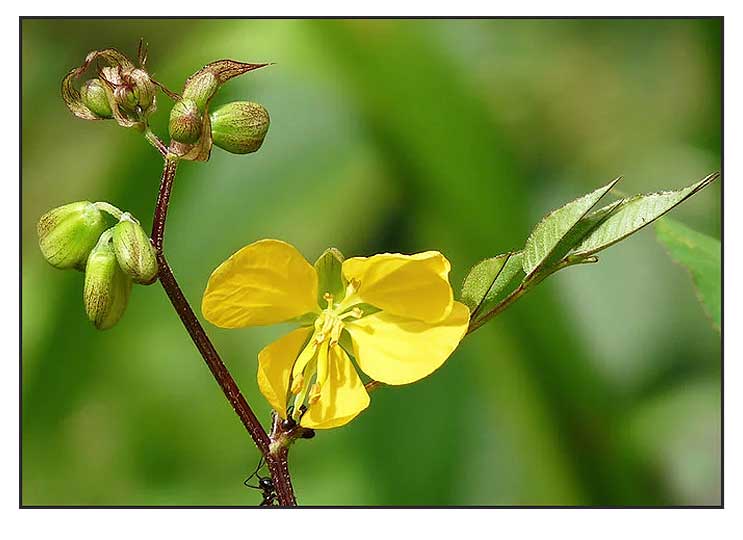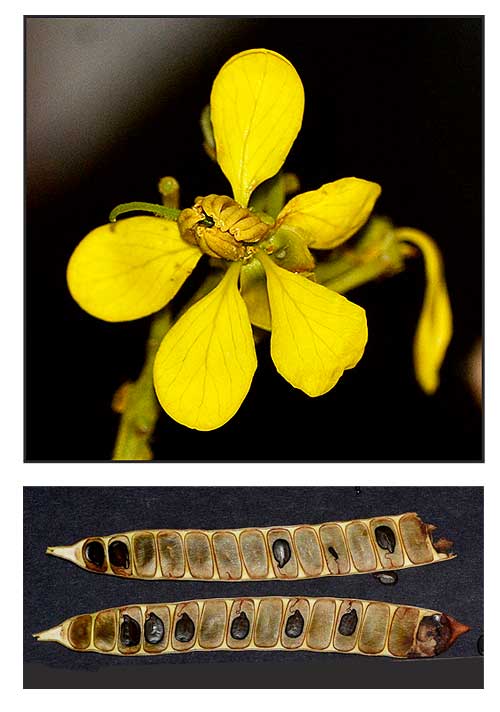 Gen info Gen info
- Senna, the sennas, is a large genus of flowering plants in the legume family, Fabaceae, with species estimated from about 260-350. It is a diverse genus native throughout the tropics, with a small number in temperate regions. (3)
- The genus Senna has a complex taxonomic history. It was introduced as Senna by Linnaeus in his concept of Cassia in Species Plantarum in 1753. In 1754, Philip Miller segregated Senna from Cassia in the 4th edition of The Gardener's Dictionary. Until 1982, many authors, following Linnaeus, did not recognize Senna and Chamaecrista, but included them in a broadly circumscribed Cassia sensu lato. Phylogenetic analysis of DNA showed them to be all monophyletic, but the relationships between the three genera have not been resolved. For now they are shown in the phylogenetic tree as a tritomy. (3)
- Etymology: The genus name Senna derives from Arabic sanā, describing plant whose leaves and pods have cathartic and laxative properties.
Botany
• Senna timoriensis is a shrub or tree with a crown that is usually dense and rounded in young trees, becoming irregular and spreading, with drooping branches as it grows older[ It usually grows from 8 - 20 meters tall, but exceptionally up to 30 meters, with a usually short bole up to 50cm in diameter.
 • A shrub or small tree 2-6 m tall that flowers and fruits. Leaves: Stipules are somewhat awl-shaped, about 2-3 mm long. Leaflet blades about 30-40 x 10-13 mm, lateral veins readily visible with a lens. Compound leaf rachis, petioles and particularly the terminal buds and young shoots clothed in yellow or golden hairs. Leaflets aristate, the hair-like appendage about 1 mm long. Flowers: Pedicels about 10 mm long. Stamens ten, seven fertile plus three small staminodes. Fertile anthers about 4-5 mm long. Ovary glabrous, about 5-7 mm long. Fruit: Pods flat, about 4.5-7 x 0.8-1.2 cm. Seeds about 9-14 per pod, flat, about 5-6 x 2 mm. Cotyledons longer than the radicle. (Australian Tropical Rainforest Plants) • A shrub or small tree 2-6 m tall that flowers and fruits. Leaves: Stipules are somewhat awl-shaped, about 2-3 mm long. Leaflet blades about 30-40 x 10-13 mm, lateral veins readily visible with a lens. Compound leaf rachis, petioles and particularly the terminal buds and young shoots clothed in yellow or golden hairs. Leaflets aristate, the hair-like appendage about 1 mm long. Flowers: Pedicels about 10 mm long. Stamens ten, seven fertile plus three small staminodes. Fertile anthers about 4-5 mm long. Ovary glabrous, about 5-7 mm long. Fruit: Pods flat, about 4.5-7 x 0.8-1.2 cm. Seeds about 9-14 per pod, flat, about 5-6 x 2 mm. Cotyledons longer than the radicle. (Australian Tropical Rainforest Plants)
Distribution
- Native to the Philippines. (1) (2)
- In Luzon: Bataan, Benguet, Bulacan, Ilocos Sur, Laguna,Nueva Ecija, Pampanga, Pangasinan, Rizal, Tarlac. In thickets. Flowers throughout the year. (1)
- Also native to Assam, Borneo, Cambodia, East Himalaya, India, Jawa, Laos, Lesser Sunda Is., Malaya, Myanmar, Northern Territory, Queensland, Sulawesi, Sumatera, Thailand, Vietnam, Western Australia. (2)
Constituents
- Phytochemical analysis of flower extracts for secondary metabolites revealed presence of flavonoids, tannins, coumarins, steroids, and terpenoids in all extracts except for aqueous extract. All extracts were negative for alkaloids. Anthraquinones were detected only in the ethyl acetate extract. The ethyl acetate extract showed highest phenoli and flavonoid contents (527.43 mg GAE/g DW and 851.83 mg QE/g DW, respectively) (see study below)
(6)
- Fractionation of methanol extract 3-methoxyquercetin (1), benzenepropanoic acid (2), 9,12,15-octa-decatrienoic acid (3), β-sitosterol (4), stigmasterol (5), and 1-octadecanol (6).
(see study below) (7)
Properties
- Studies have suggested antioxidant, anti-inflammatory, acetylcholinesterase inhibitory properties.
Parts used
Leaves, bark, pod, flowers.
 Uses Uses
Edibility
- Young leaves, flowers, and young fruits eaten after soaking 2-3 times in hot water to remove toxin, although still bitter. (4)
- Boiled as vegetable and served with chili sauce.
Folkloric
- In Samar, used for treatment of scabies and dysentery. (8)
- Bark used for treatment of scabies. Seed pods used as anthelmintic. (4)
- In Thailand, preparations from heartwood used to stimulate menstruation. (5) Also used for treatment of cough, blood stasis, tumors, and as tonic.
Others
- Wood: Used for various construction purposes; favored for axe handles, boxes, and joinery. Highly resistant to insect attacks. (4)
- Agroforestry: Suitable for mixed reforestation for soil protection purposes. (4)
Studies
• Antioxidant / Anti-Inflammatory / Acetylcholinesterase Inhibitory / Flowers: Study evaluated the invitro activities of various flower extracts for acetylcholinesterase (AChE) inhibitory potential, radical scavenging ability, and anti-inflammatory properties. The ethyl acetate extract and methanol extracts showed highest antioxidant (IC50s of 20.12 and 34.48 µg/mL, respectively), anti-inflammatory (92.50 and 92.22, respectively), and anti-AChE (IC50 6.91 and 6.40 µg/mL, respectively) activities. Results suggest presence of bioactive compounds that can help in treatment of neurodegenerative disorders, including Alzheimer's disease, through high antioxidant, anti-inflammatory and anti-AChE activities. (see constituents above) (6)
• Anti-Acetylcholinesterase Activity / Flowers: Study screened 17 methanol extracts from different plant parts of five Cassia species viz., C. timorensis, C. grandis, C. fistula, C. spectabilis, and C. alata against acetylcholinesterase (AChE). C. timorensis extracts showed highest inhibition of AChE, with leaf, stem, and flower methanol extracts showing 94-97% inhibition. Further fractionation identified six compounds viz., 3-methoxyquercetin (1), benzenepropanoic acid (2), 9,12,15-octadecatrienoic acid (3), β-sitosterol (4), stigmasterol (5), and 1-octadecanol (6). Compound 1 showed moderate AChE inhibition with IC50 83.71 µM, with mechanism of activity possibly through blocking of entry of acetylcholine (ACh, the neurotransmitter), thus impeding the hydrolysis of ACh. (7)
Availability
- Wild-crafted.
- Seeds in the cybermarket.
|

![]()






